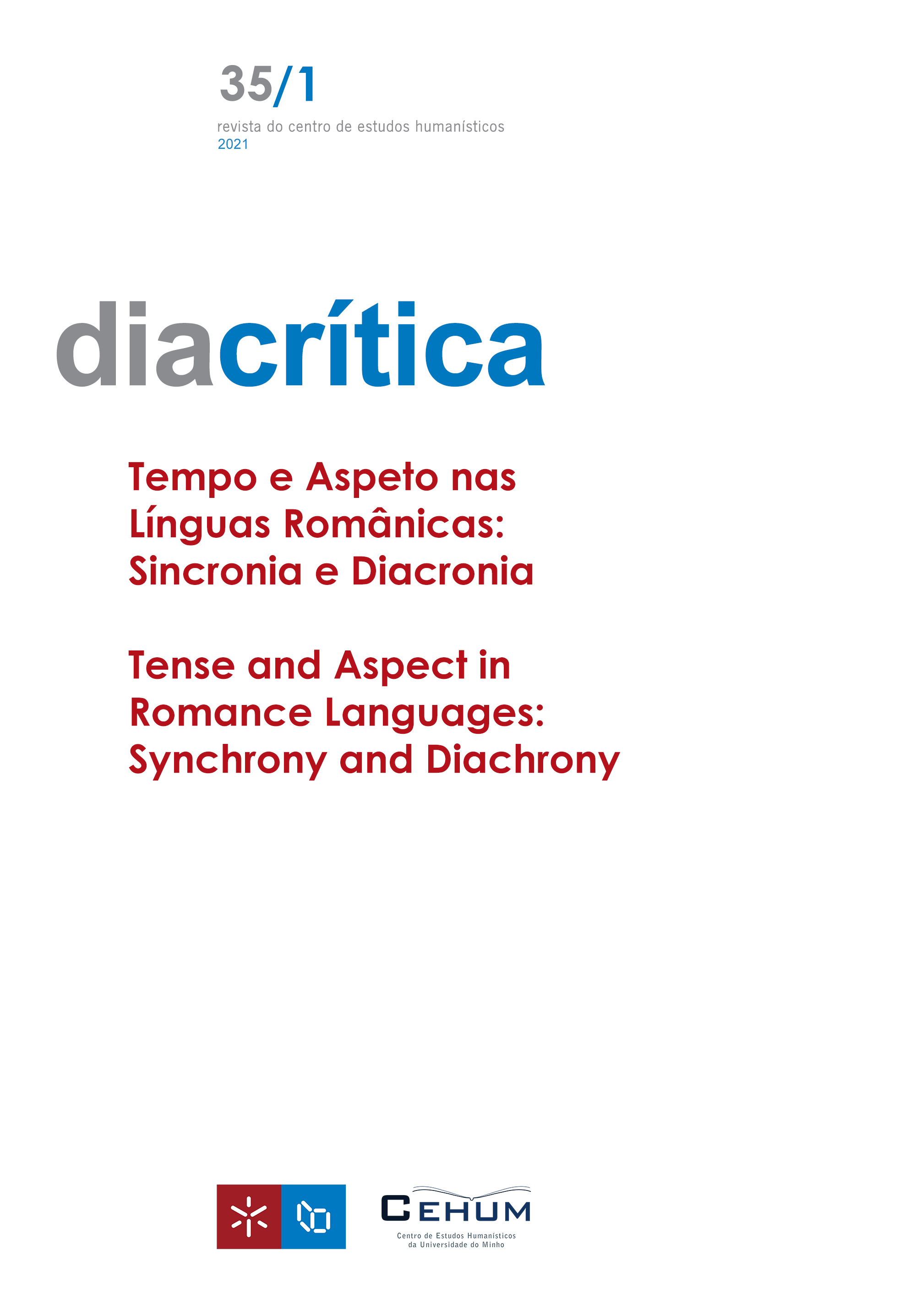Aspectual constructions [andar + gerund] and [viver + gerund] in Portuguese
DOI:
https://doi.org/10.21814/diacritica.5112Keywords:
Verbal aspect, Verbal construction, Linguistic variantAbstract
This work chose as object of study two aspectual constructions of the Portuguese language: [V1ANDAR (TO WALK)+ V2GERUND] e V1VIVER (TO LIVE) + V2GERUND]. Based on a quantitative and a qualitative analysis of 542 data collected in the Corpus do Portuguêsdatabase (https://www.corpusdoportugues.org/), in a synchronous profile that includes three centuries (XVIII, XIX and XX), we evaluated the hypothesis that such constructions would be linguistic variants. The results showed that, despite both constructions evoking the notion of iteration, they are not linguistic variants. It was found that the construction whose auxiliary is the verb VIVER (TO LIVE) denotes an aspectual notion whose internal time limit is unknown, while the construction whose auxiliary verb is ANDAR (TO WALK) translates an aspectual notion whose time limit and duration are known. It was also identified that the constructions introduced by the verb ANDAR (TO WALK) are more likely to be ambiguous than those introduced by the verb VIVER (TO LIVE).
References
Alzamora, H. I. (2018). As perífrases verbais no português europeu contemporâneo (Tese de doutoramento, Universidade Nova de Lisboa, Lisboa).
Barroso, H. (1994). O aspecto verbal perifrástico em português contemporâneo: Visão funcional/sincrónica. Porto: Porto Editora.
Barroso, H. (2009). Progressivo, progressivo comitativo e progressivo gradativo no PE da actualidade: Expressão, combinatória e variação. VI Congresso Internacional da ABRALIN, João Pessoa, 1, 3603–3615.
Câmara Júnior, J. M. (1970). Estrutura da língua portuguesa. Petrópolis: Vozes.
Castilho, A. T. (1968). Introdução ao estudo do aspecto verbal na língua portuguesa. Marília: Faculdade de Filosofia Ciências e Letras.
Comrie, B. (1976). Aspect: An introduction to the study of verbal aspect and related problems. Cambridge: Cambridge Textbooks in Linguistics.
Costa, S. B. B. (2002). O aspecto em português (3.a ed.). São Paulo: Contexto.
Cunha, L. F. (2006). Frequência vs habitualidade: Distinções e convergências. Actas del XXXV Simposio Internacional de la Sociedad Española de Linguística, 333–357. Consultado em http://fhyc.unileon.es/SEL/actas/Cunha.pdf
Davies, M., & Ferreira, M. (2006). Corpus do Português (45 milhões de palavras, sécs. XIV-XX). Consultado em outubro 2013 em http://www.corpusdoportugues.org
Drumond, G. S. P. (2014). Gramaticalização das construções V1(a)garrar + PrepA + V2infinitivo e V1pegar + PrepA + V2infinitivo como marcadores aspectuais no português. Belo Horizonte: Universidade Federal de Minas Gerais.
Ferrari, L. (2014). Introdução à linguística cognitiva. São Paulo: Contexto.
Goldberg, A. E. (1995). Constructions: A construction’s grammar approach to argument structure. Chicago: Chicago University Press.
Mateus, M. H. M., Brito, A. M., Duarte, I., Faria, I. H., Frota, S., Matos, G., Villalva, A. et al. (2003). Gramática da Língua Portuguesa (5.ª ed. revista e aumentada). Lisboa: Caminho.
Oliveira, F., Cunha, L. F., & Matos, S. (2000). Alguns operadores aspectuais em PE e PB. Actas do XVI Encontro Nacional da Associação Portuguesa de Linguística, Coimbra, 737–749. Consultado em https://apl.pt/wp-content/uploads/2017/12/2000-58.pdf
Rafael, G. C. R. A. (2016). Estudo comparativo sobre o uso de construções aspectuais inceptivas no português brasileiro e no português europeu (Dissertação de mestrado, Universidade Federal de Minas Gerais, Belo Horizonte).
Sousa, O. (2007). Perífrases aspectuais: estar a/andar a + infinitivo. In M. Lobo & M. A. Coutinho (Eds.), XXII Encontro da Associação Portuguesa de Linguística (pp. 637–648). Lisboa: APL.
Tarallo, F. (1986). A pesquisa sociolinguística. São Paulo: Ática.
Travaglia, L. C. (2014). O aspecto verbal no português: A categoria e sua expressão (5.a ed.). Uberlândia: EDUFU. (Obra original publicada em 1985).
Vitral, L. T., & Coelho, S. M. (2019). A auxiliarização em Português: Aspecto, novas formas e implicações teóricas. In C. Galves, M. A. Kato, & I. Roberts (Eds.), Português brasileiro: uma segunda viagem diacrônica (pp. 253–282). Campinas, São Paulo: Editora da Unicamp.
Wachowicz, T. C. (2004). Marcas lingüísticas de iteratividade em PB. In Anais do 6º Encontro Celsul - Círculo de Estudos Lingüísticos do Sul, Florianópolis, Santa Catarina. Consultado em http://www.leffa.pro.br/tela4/Textos/Textos/Anais/CELSUL_VI/index.htm
Downloads
Published
How to Cite
Issue
Section
License
Copyright (c) 2023 Ana Clara Teixeira Ferreira, Sueli Maria Coelho

This work is licensed under a Creative Commons Attribution-NonCommercial 4.0 International License.










